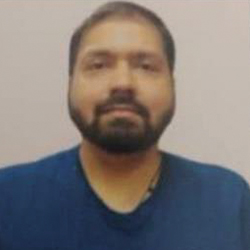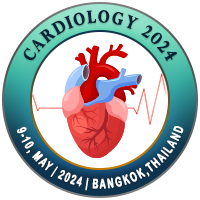
Shobhit Mathur
U N Mehta Institute of Cardiology and Research Center, IndiaTitle: Tricuspid valve replacement outcomes in a diverse variety of valve replacement cases: Mortality, mechanical versus biological – A single?center study
Abstract
The initial trial in tricuspid surgery is repair; however, replacement is done whenever the valve is badly diseased. Tricuspid valve replacement (TVR) as an isolated procedure and combined with other valve replacements presents a challenge as these patients are in the high‑risk subset. The present retrospective study was performed using the medical records of 42 cases who underwent TVR in 2017 at our institute. The mean age of the participants was 36.3 ± 13.2 years and male females were 66.7% and 33.3%, respectively. Isolated TVR was done in 35.7% of cases, associated with mitral valve replacement (MVR) in 38.1%, with aortic valve replacement (AVR) in 4.8%, triple‑valve replacement (MV, TV, and AV) in 19.0%, and TVR associated with pulmonary valve replacement in 2.4% of cases. This diverse variety of valve replacement cases is the highlight of our study. About 30.9% of participants were undergoing the procedure as a redo surgery. A trial of repair was given in 33.3% of cases. bioprosthesis and mechanical valve prosthesis were used in 73.8% and 26.2%, respectively. Early mortality occurred in 8 (19.0%) cases. Cause of death common in all was right ventricular failure in all cases 8/8 (100%) seconded by multi‑organ failure in 7/8 cases (87.5%), previous cardiac surgery was a factor in 4/8 (50%) cases, mediastinitis occurred in 2/8 (25%) cases, and both arrhythmias and cerebrovascular accident happened in 1/8 (12.5%) case each. The mortality rate was 3/15 (20.0%) in cases of isolated TV surgery. The mortality rate for concomitant MVR was 3/15 (20.0%), and for concomitant AVR with MVR (triple‑valve replacement) was 2/8 (25.0%). No early mortality happened in the concomitant AVR and concomitant pulmonary valve replacement group. Late mortality happened in 11/42 (26.2%) cases during follow‑up. Total mortality as per the valve types has been 5/11 (45.5%) in the mechanical valve replacement group and 14/31 (45.2%) in the biological valve group. We conclude that patients who require TVR are high‑risk surgical candidates with high early and late mortality. Most common cause of death was right ventricular failure. TVR associated with other heart valve replacement increases the risk strata of the patient which is the highlight of our study. In the end, we had 19.0% early (0–30 days) and 26.2% late mortality (0–1 year) making a composite of 45.2% mortality at the end of 1 year. No difference in the effect of mortality as per the valve type has been observed.
Biography
Dr (Maj) Shobhit Mathur is an alumnus of the prestigious Armed Forces Medical College, Pune. He is a proud veteran who after commissioning into the elite Indian Army gave services to the nation for seven years and was released in the rank of major. After finishing the national service, he completed his Master in Surgery (year 2014-17) from the renowned Army Hospital Research & Referral (AHRR), New Delhi, and then pursued his CVTS residency (year 2017-20) from the Apex Sawai Man Singh Medical College & Hospital in Jaipur, Rajasthan. He is presently serving as Assistant Professor CVTS at UN Mehta Institute of Cardiology and Research Center, Ahmedabad which is a class 1251 bedded India`s largest single specialty hospital. As a cardiac surgeon, his interests are to excel in coronary, adult, aortic, and vascular surgery. He has publications during his CVTS residency and his interest in research continues. He has also one poster on hemothorax selected and published in the International Trauma Congress 2016 held in New Delhi during his general surgery residency. The idea for the present article germinated from the fact that the tricuspid is treated as a forgotten valve and hence under the guidance of his senior professors he endeavored to take this challenge.

